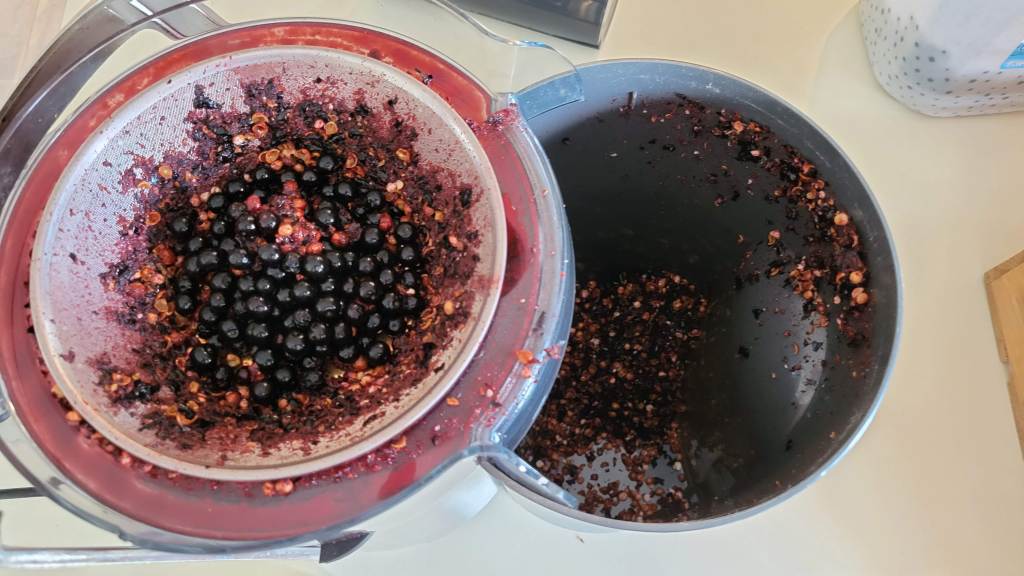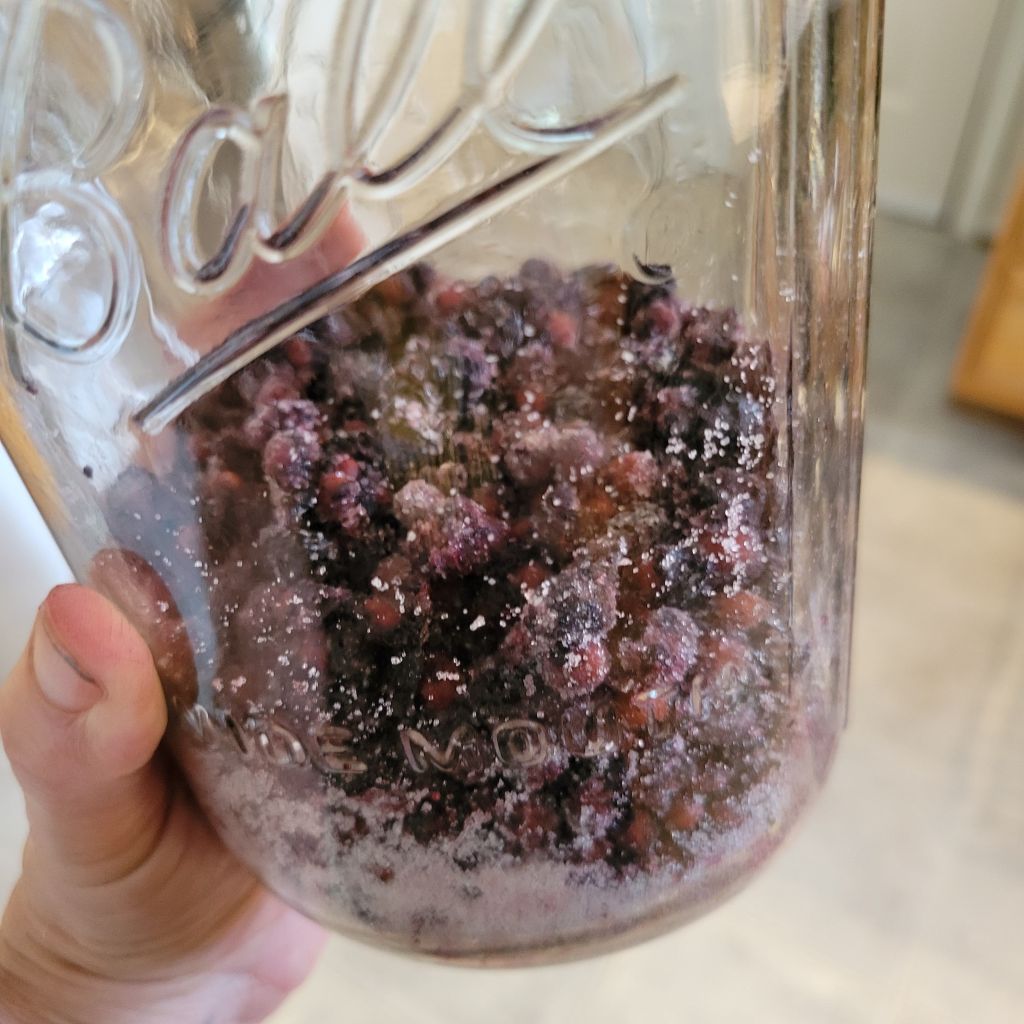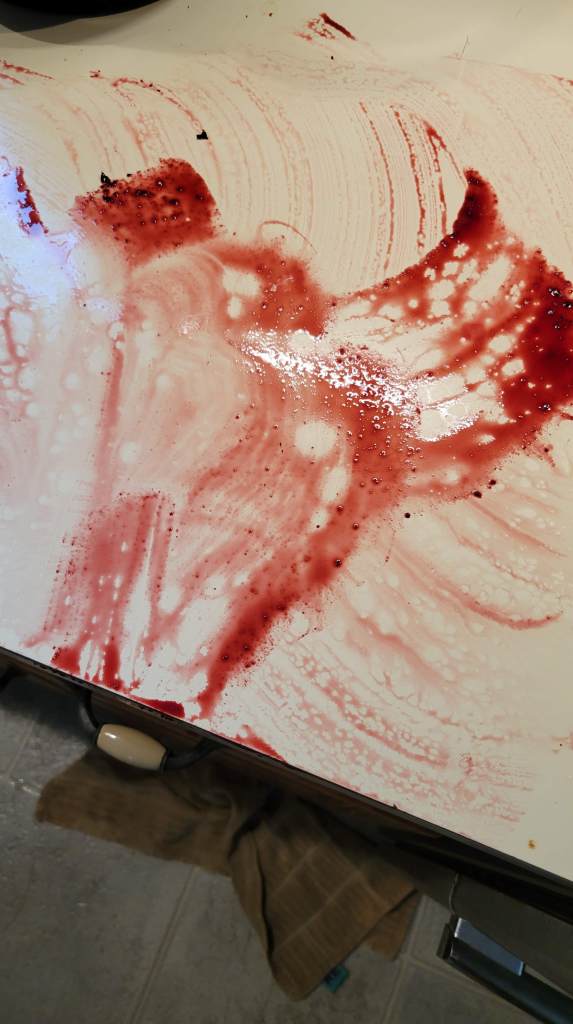Today’s tale of woe is brought to you by black cherries (Prunus serotina). Lo, these many years (OK, just two – 2019 and 2020) I have been thwarted in my attempt to harvest and use black cherries, even though a tree grows in my very own yard.
In 2021, however, I was miraculously blessed with black cherry abundance.
Giddy with excitement, I sliced off the top of a plastic jug and started stripping the ripe cherries from the racemes (long flower stalks, now dotted along the length with fruit) into the jug. The previous two years the tree offered little or no fruit – what made this year different? Did the the heat and lack of rain somehow help this feral tree? Did the mysterious disease killing song birds across the mid-Atlantic play a role by removing the fruit’s primary benefactors? I pushed these thoughts out of my head as I continued to collect the little black treasures.

Did I say “treasures”? I only mean that in the sense of “I value them very highly because they are so rare in my existence.” The fruit itself is actually unpleasant to eat: not particularly sweet, and featuring a massive single seed.
Oh, did I mention the seed is poisonous? I have read variously that the seeds contain cyanogenic glycoside, amygdalin, and/or prussic acid. (The wilted leaves and stems likewise.) Heating the pits will break down the toxins (similar to elderberries), so you have two options: removing them or cooking them to use the fruit.
Lesson one in how NOT to remove them: fancy juicing machine.

What you see there – besides a mess that took hours to clean from every crack and crevice of the juicer – is shredded cherry pits and exposed kernels. This is not okay. An intact shell prevents the toxic kernels from leaking its life juices all over the cherry pulp. I carefully extracted the undamaged, whole cherries and composted the rest.
How not to process black cherries, #2. Hand crank food mill. Yes, I know this is what Marie Viljoen describes using in Forage, Harvest, Feast. But it, too, resulted in disaster.

The black cherry pits kept the grinding plate from moving smoothly across the coarse stainless steel disk with its teeth and wide holes. So we’d crank forward, then crank backward, then crank forward again. A paltry trickle of pulp drained into the large glass measuring cup we set the food mill over.
The food mill, which has no way to lock into place on the measuring cup or bowl or plate or whatever receptacle you’re using to capture the “fruits” of your labor. I’ve always hated this lack of feature, but I have yet to find a hand-cranked food mill which offers some alternative. So you crank hard against the black cherry pits, with no real way to keep leverage on it because it’s precariously resting on a four cup measuring glass…. until suddenly it isn’t anymore.
You watch, horrified, everything in slow motion, like a movie scene as the measuring glass topples and all that hard earned black cherry pulp spills all over your counter and pours onto the floor.
You frantically start cleaning it up before it can stain the linoleum countertops… and then remember to pause and snap a photo for social media.
(Okay, not a great photo.)
I thought about digging out my other food mill, the conical one, but I didn’t think it would fare better than the hand cranked option. For the record, it also doesn’t have a way to conveniently fit on or over a bowl, or otherwise secure to a receptacle for the juice and pulp, and generally also results in a mess.
Plus, at this point I’d lost over half my precious black cherry harvest, from 2.8 lbs down to 1.1 lb of fruit which I hadn’t yet tried to juice. No more chances!
But first: to contend with the portion I did try to juice. I tediously picked through the crushed black cherry bits, separating the mostly-intact fruit from bits of crushed shell and exposed kernels.

At the end of this mind-numbing task, I had just enough intact fruit / pits for Viljoen’s Black Cherry Rum recipe, from Forage, Harvest, Feast (yes, that book agaaaaaaaaain). Into a jar with sugar!

(For someone who tries to avoid sugar, an awful lot of recipes I fix start this way…)
I added the remaining 1.1 lb of fruit to a pot with 4 lbs of elderberries for this year’s version of elderberry wine. Last year I had blackberries in abundance, but unfortunately my canes have all succumbed to one affliction or another (as I lamented in my annual garden update). So this time around, I’ll have black cherry and elderberry wine. Because the first step in the instructions involves simmering the fruit, and heat denatures the toxins, I have no fear of the pits of either fruit.
Although honestly 1) after a week you remove the fruit solids so the pits would have been removed anyway and 2) Viljoen herself indicates that fermenting elderberries at least neutralizes the toxins so maybe that would happen to black cherry pits in wine as well.

Now the real question. Do I save the pits from the black cherry rum and the wine must to make mahlab? Viljoen provides instructions in her book, and I should have plenty of pits from which to liberate and roast the kernels. Again, it sounds pretty tedious… and I have no idea what I will use mahlab for anyway… but there’s part of me that’s clearly a glutton for punishment!
What foraging adventures are you experiencing as summer reaches its zenith?


[…] Wild grapes (Vitis spp.). Amazingly enough, this year I FINALLY found wild grapes within extremely easy reach. No excuses to not try them this fall! Now is the ideal time to figure out how to use them. Because of the size of the seed and high tartaric acid content, they need to be juiced rather than eaten … hopefully this goes better than when I tried to extract juice from black cherries! […]
[…] current debate: mahlab. I was so excited with my black cherry harvest this year (despite the mess I made processing them), I want to make Every. Single. Recipe. possible with them. I started a batch of black […]
[…] and foremost, there seems to be no good way to avoid making a huge mess while processing the black cherries to use them in the first place. Because the kernels contain cyanogenic glycosides, care must be […]
I can add to this list. Don’t try steam juicers either. They work technically but I ran the stove for hours and extracted maybe 1 cup of juice. It was such an endeavor to find a steam juicer too.
The last three years I’ve done chokecherry wine (similar small cherry with a big pit) by boiling then hand straining through fabric. Makes a huge mess and hurts the hands but the wine is excellent. Maybe I ought to try just putting the whole berry in primary fermentation like you did.